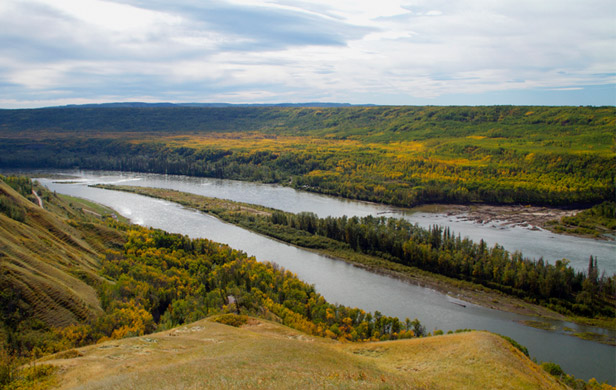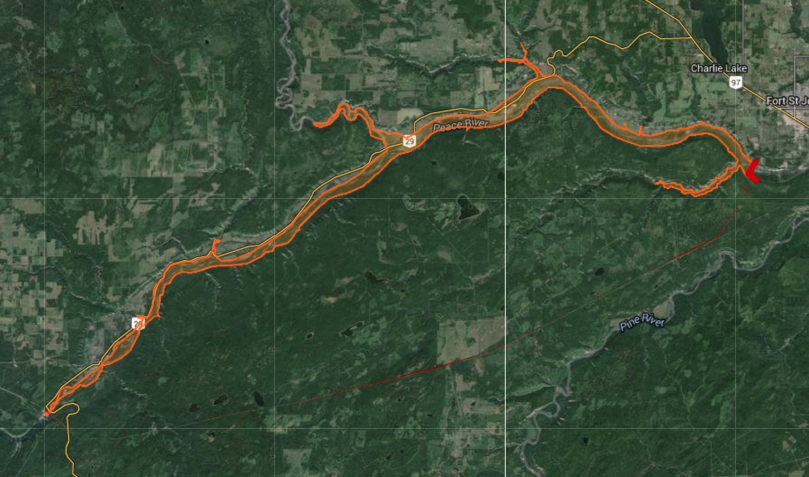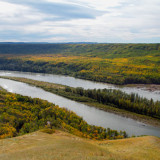
The federal government struck out in court Friday in its attempt to gut key passages of a Treaty 8 First Nations Judicial Review into the environmental certificate for Site C Dam.
After 3 hours of arguments on the crown’s motion to strike, brought with the support of the province, the presiding Prothonotary Lafreniere not only threw out the government’s argument – which he called “a very rare request” – but ordered costs be paid to the First Nation plaintiff. The decision presents another legal roadblock to the $9 Billion dam, on which the BC Liberal government and proponent BC Hydro intended to break ground this summer. The federal judicial review is now slated to be heard in July, with the nation’s key argument of rights infringement by the dam fully before the court. The Judicial Review is being brought jointly by West Moberly First Nations, the Prophet River First Nation, McLeod Lake Indian Band, and Doig River First Nation.
The right to be heard
At issue in Friday’s hearing was a highly technical but significant debate over whether a Judicial Review is equipped to deal with an Aboriginal rights-based argument. Both the crown and province maintained that in the past, the courts have refused to hear such arguments in a Judicial Review – referring them instead to full-on trials. The First Nation argues that the environmental review process and subsequent decisions by governments to award Site C its certificates failed to consider the infringement of its treaty rights to hunt, fish and trap on the land – unimpeded by development.
The crown countered that the matter of rights infringement falls outside of the scope of the environmental review – parameters that the government deliberately hardwired into the terms of reference for the Joint Review Panel. In other words, both the federal and provincial governments ensured that the questions of rights infringement never enter into the JRP hearings – even though the panel readily acknowledged the project would have adverse impacts on First Nations throughout the region.
“Put it to bed”
The crown argued that the plaintiff’s evidence and legal standing was “so utterly devoid of merit and hopeless that…it should be struck out and put to bed early on.”
Prothonotary Lafreniere disagreed. During the hearing, he challenged the crown’s argument that the rights issue couldn’t be adjudicated by a Judicial Review:
[quote]Why can’t you argue that in the hearing?…I’m very concerned about bringing a motion to throw them out before getting a fair hearing.[/quote]
Counsel: Govt totally ignored First Nations’ rights
In her clients’ defense, Lead Counsel Allisun Rana drew attention to the government’s carefully contemplated refusal to address meaningfully the Nation’s rights. While the JRP’s hands were tied from dealing directly with rights infringement – a loaded legal notion that goes deeper than merely observing adverse impacts – the government was supposed to consider the evidence gathered and deal with the rights issue later, before issuing its decision. It chose not to, whatsoever – a revelation that only came to to light through this recent motion to strike. Even the plaintiff seemed surprised to learn that no consideration was given at any point to the infringement by the dam on First Nations’ treaty rights.
The crown’s own consultation report on Site C contained a clearly-stipulated responsibility for the government to deal with rights infringement issues – as reflected in the report’s consultation schematic. Only later, without the nation’s knowledge, did the crown alter the language in the schematic to say “determining impacts” instead of “infringement“. Legally speaking, this one word makes all the difference as it speaks specifically to the breaking of legal promises made in Treaty 8 of 1899.
“[My clients] had a good faith belief that the governor in council would consider infringement and were led to believe that by the agency,” Rana told the court.
[quote]If the project is an infringement on First Nations’ rights and the governor in council approved it, then that’s a constitutional issue…that is a matter that needs to be heard before a full hearing.[/quote]
A big decision

“This is a project that will take up half of what remains of the Peace River in BC,” Rana added. “There are no First Nations in support, no impact benefit agreements in place…This is a big decision.”
While the crown argued that the plaintiff is “trying to go through the back door” in raising issues at a Judicial Review which both governments have clearly sought to keep off the table, the court disagreed. “It’s good to have this behind us,” said Rana on Friday’s decision, “so we can focus on the Judicial Review.”
The decision, just one in a long list of legal developments currently surrounding the controversial dam, is another troubling sign for governments which seem in a real hurry to get construction underway.
Perhaps that’s because they can feel the judicial sands shifting beneath their feet. And like quicksand, the harder they struggle, the deeper they may find themselves stuck.


Can’t wait for the new dam to go in. Should bring a lot more work and money to town. Also it will be nice to go boating and exploring on the new lake:)
What a moronic statement, “Exploring on the new dam”. What and where are you going to be exploring, “Flooded trees and flooded animal habitat”? Interesting to who, Foreign Investors, surely not Canadians who love this Province and all it means to us and the World? To He11 in a hand basket comes to mind.
Sorry Mooney but I know little about NERC and that is the way they like it.
NERC is a private corporation based in Texas who is by presidential order in total charge of the wholesale level of electricity in North America.
Given that Federal Reserve type charter it should be no surprise the disclosure is very minimal.
BCH has been getting more sneaky about their reports and we are soon to see the Fiscal 215 annuals.
BCH is in defensive mode so less detail should be expected.
BCH used to publish a “forecast” of demand annually but I think they have stopped for obvious reasons. Too much ammunitions in the hands of critics is too awkward.
May 12, 2015
Today it was announced the Site C Dam site clearing will begin shortly and trades would be submitting tenders. How in the hell can that proceed until court appeals have been heard and ruled on. Is Hydro so powerful they needn’t abide by democratic laws? The BC Liberals/BC Hydro qualify for dictator status.
The govt does what ever it wants until protests or elections stop them
…or court injunctions.
😉
A very apt question, Salal. If they keep on this path, it will likely open the door to an interlocutory injunction by the First Nations and/or land owners…
It’s a malfunction at the junction. Some kind of mental anorexia is necessary before a government and crown corporation could propose to build something that isn’t needed, at a cost that is unverifiable, with largely unknown impacts on the environment and resources of the valley and the people directly affected. We don’t know, we don’t want to know, we won’t be able to have our own image of ourselves if we know.
Maybe, being unable to sell this turkey on its own merits, they think that spending hundreds of millions of dollars will make it “too late to stop now” but aren’t we aware that there is a point where you don’t throw good money after bad? I seem to have heard that thrown around as part of the Common Sense for quite a while now.
I appreciate the detail in the story, thank you. But no thanks to the respective governments who are in some kind of ‘spend ourselves out of debt’ mode.
I will never forget the expropriation of my home town and surrounding farmland just northeast of Toronto in the late sixties (known as the Pickering Airport, a proposed overflow for Pearson Airport just northwest of TO, almost half of an entire county was expropriated for the airport and a satellite city—neither of which was ever built. The Ontario government still owns most of this land forty-odd years later). My Dad ended up renting the house he’d built just outside the village of Whitevale (est. 1828)—for almost 30 years. One of my best friend’s dad had a heart attack and died fighting the expropriation. Years later, when most of the victims were senior citizens, the government had the temerity to offer them back the immediate grounds about their houses—at the going real estate rate. Within months of first finding out, the government had demolished some seventy homesteads, hand built, often squared oak and beech log cabins faced with field stones (jokingly called our most plentiful crop) when, after a generation or two, the farm had produced a bit of extra cash. Sharp-eyed antique dealers snatched door knobs, gothic windows, bottles, whatever could be salvaged before the ball smashed the rest to pieces. Some of my friends would pick gingerbread mouldings from the rubble. The odd place was rented to back-to-the-landers from the States (which was at war in Viet Nam).
By the time the expropriation became common knowledge, a hundred or so original farmsteads had already been expropriated. This was the premise for continuing the expropriations even as legal challenges were initiated (the courts prohibited class action and opted for public hearings instead) — that it was “too late to turn back now”. Government agents cleverly started expropriating the oldest farmers, great- and great-great grandsons of the original settlers whose own kids had eschewed the farming life in favour of jobs in the city which was then just being accessed by ten and twenty-lane commuter highways. Many of these farms, though verdant (75 bushels of wheat per acre compared to 25 in the Prairies), were deemed too small to be viable (most were about 110 acres, mixed farming still in evidence as crooked old orchards and overgrown gardens, small, cross-fenced fields and numerous barns). Many of these old timers were convinced they had to take the first offer, but, after all, they’d inherited the land, they were old, with no one to take over. Non-farmers like my Dad (he commuted to TO every day and hobby-farmed on weekends) were able to get triple the first offer only after ten or fifteen years of trials.
I used to cultivate the same outrage as my community’s (in all, several small towns and thousands of acres of prime land were at stake)—how could something like this happen in a democratic country like Canada? Mackenzie had mustered volunteers for the Upper Canada Rebellion along the corduroy Fifth Concession in 1837; we couldn’t forget that; the first NDP MPP was elected in our riding in protest—didn’t help. Since their were very few First Nations—or even Catholics—in this area, I didn’t really understand, until I moved out West, that there had indeed been even greater injustices done by governments highhandedly snatching land. When big contract farm machinery started working now-rented land, and the spring air was choked with untold tons of Atrazine in preparation for endless monoculture of corn, I knew nothing was going to stop this fix. That’s why I moved out west–seventeen years old, happy to exchange this tragedy for the hippie world on the Coast. A decade later, many of my school chums were, like me, working in Port Alberni, about ten per cent of our home town’s population. And for a spell the old county was home to a sad geriatric rump while barns were stripped of their boards by night to decorate the interiors of toni townhouses in Hogtown.
As I read this incredible interruption of government highhandedness in the Peace, I’m overjoyed. Maybe that memorable “it’s too late to stop now” will be converted into “it’s too late to start now”. I never believed this damn was necessary, much less the BC Liberal claim to have its financing well in hand—not just because they are notorious liars, but because it just doesn’t make sense. Now I have hope it will represent some justice for the victims of profiteers who’ve stolen so much land and co-opted our governments. And that this land will provide for generations—not generators— to come.
Epilogue: in a supreme twist of irony, my old hometown remains, because the government still owns this land for some unstated purpose (perhaps waiting for the last of their potential false expropriation plaintiffs to die off—no airport or satellite city were ever built), virtually the same as when I left four and-a-half decades ago, while to the south, east and west subdivisions of apartment buildings and shopping malls have permanently disguised the land as it was back then. I know because my brother and I met my son, mother and sister at the country cemetery on a beautiful summer day, with fields of blooming mustard lilting in the breeze, to bury my Dad who, in his mid-eighties, had been taken away from his beloved Whitevale a few years before to be closer to my brother—and he’s still there today. I know exactly what he would say about Site-C.
Thank you for sharing.
It has been and still is the Government’s practice to keep as much relevant information pertaining to the Site C project out of the Public eye and away from independent formal review.
Why you might ask and the answer coming back would likely be the Government does not wish to confront the reality of the global economic slowdown now underway.
In 2009, following a global collapse of the banking sector, a bellwether index of global economic health, the Baltic Dry Cargo Index, fell from about 13,000 to just below 600 points. That is a 95% decrease in international dry cargo shipping rates combined with volumes in under 8 months. There was a “dead cat bounce” in 2011, up to about 2,000 followed by a definite return to lower values. Since February 2015 the index has struggled at under 600 points.
There is currently no need for the electricity from Site C and there is not likely to be new need for at least the next 20 years, by which time the world beyond BC will be busy transitioning from 20th century ideas and grappling with the 21st century technologies.
Interesting and well stated.
What do you hear about NERC and the control system of heavy fines they hold over our BC Hydro these days Mr. Anderson?
I ask because I’m having problems finding much information.